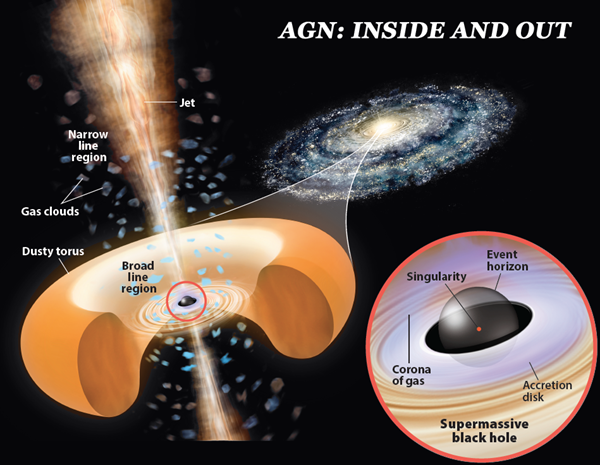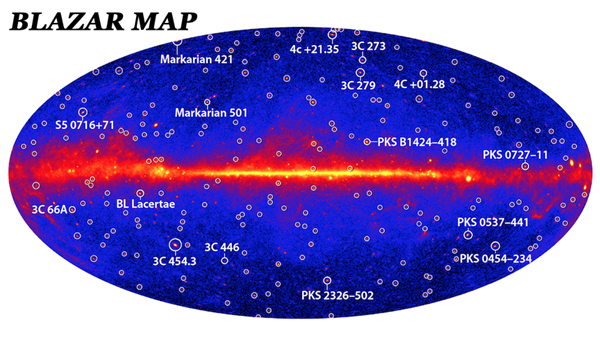Key Takeaways:
- Active Galactic Nuclei (AGN) are luminous central regions of galaxies, powered by supermassive black holes accreting matter, which converts gravitational potential energy into radiation across the electromagnetic spectrum.
- The discovery of highly redshifted, extremely luminous quasi-stellar objects (quasars) in the 1960s established them as distant galactic nuclei, augmenting earlier identifications of nearby, less powerful Seyfert galaxies.
- The unified model of AGN posits that diverse observational characteristics, such as quasars and Seyfert galaxies, stem from a common underlying structure—comprising a supermassive black hole, accretion disk, and surrounding gas and dust torus—viewed from different angles.
- AGN activity, particularly the early quasar phase, is intrinsically linked to galaxy evolution, with feedback mechanisms from the central engine potentially influencing star formation and shaping the overall development of the host galaxy.
In a galaxy like the Milky Way, light comes entirely from a combination of shining stars and glowing gas. However, in an active galaxy, the energy output is too high to attribute to these factors alone. The excess energy is concentrated in the galaxy’s center — its active galactic nucleus.
Active galactic nuclei (AGN) are found throughout the cosmos in many forms. Some hide within seemingly normal galaxies, while the brightest pump out so much energy they outshine their host galaxy entirely. AGN are manifestations of the supermassive black holes found in nearly every galaxy we see, and they have played an important role in shaping the universe.
Quasi-stellar objects
Observations of galactic centers had turned up odd results since the early 1900s, but initially received little attention. By the late 1950s, astronomers surveying the sky with radio telescopes were attempting to match radio sources with visible objects such as stars and galaxies. They discovered that while many optical counterparts were normal-looking galaxies, some appeared as bright blue stars often embedded in fuzzy halos barely discernible in the wash of light from the star.
These oddballs, initially dubbed “radio stars” and later “quasi-stellar radio sources,” remained mysterious until 1963, when Dutch astronomer Maarten Schmidt observed the starlike counterpart of radio source 3C 273 from Palomar Observatory in California. He examined the source’s spectra, spreading out the light by wavelength to identify features associated with the emission and absorption of energy by different atoms.
Shortly afterward, astronomers revisited the spectrum of a different radio star, 3C 48, and identified features associated with a redshift of 0.3679, corresponding to a distance of over 4 billion light-years. Measurements of more quasi-stellar objects followed, all extremely distant. Soon after, the term quasar was coined. By 1973, a paper by Jerome Kristian in The Astrophysical Journal concluded that “all quasars occur in the nuclei of giant galaxies.” They appear starlike because they are so bright that the galaxy around them cannot be easily seen.
More classes pop up
Not all AGN are so dramatic. In 1943, Carl Seyfert reported several nearby, normal-looking spiral galaxies with unusually bright nuclei. Their centers displayed high-energy emission that could not come from stars. Galaxies like these are now called Seyfert galaxies; their AGN are only a fraction of the host galaxies’ total light.
Many AGN emit X-rays, showing up in surveys of those wavelengths. Astronomers also find AGN shining in infrared light, as their high-energy emission is absorbed by dust and re-emitted at longer wavelengths.
Powering the engine
After the discovery of 3C 273, astronomers introduced ideas for power sources that included bursts of star formation or supernovae, and exotic options such as supermassive stars, huge pulsars, or supermassive black holes.
In 1969, Donald Lynden-Bell showed that the gravitational potential energy around a black hole with a mass of 10 billion Suns and squeezed into a space 10 light-hours across could more than account for the energy outputs of quasars. He argued that matter falling at varying rates into black holes with a range of masses could explain all AGN, from low-energy Seyfert galaxies to high-energy quasars.
Astronomers now believe supermassive black holes reside in the centers of nearly all galaxies. Accretion onto these black holes is the “central engine” powering AGN. Infalling matter forms a swirling accretion disk as it approaches the black hole. As material moves from the outer disk toward the event horizon, its gravitational potential energy is converted into radiation across the spectrum. Not all galaxies are considered active, though, even if the black hole is feeding. But if there’s enough accretion, we see AGN.
“The evolution of quasars and the evolution of galaxies look very similar, and they’re actually very closely linked,” says Patrick McCarthy, staff scientist at the Carnegie Institution for Science and vice president of the Giant Magellan Telescope Organization. Indeed, the largest number of quasars is found at the same time most galaxies in the universe were forming the bulk of their stars, between redshifts 2 and 3. There are no quasars closer than 600 million light-years, meaning none still exist today. Closer AGN are not quasars, but lower-luminosity Seyfert galaxies.
A unified theory
The unified theory of AGN explains their different properties through orientation effects. It states that all AGN are the same type of object viewed from different angles, and all share similar features, whether they are visible or not.
Every active galactic nucleus begins with a supermassive black hole, typically defined as an object with 1 million solar masses or more. Its event horizon is light-hours across. Just above it is the accretion disk and a hot, spherical corona of gas. These stretch a few light-days across. At a distance of about 100 light-days is a region of fast-moving gas. About 100 light-years out, the AGN is surrounded by a torus — a doughnut-shaped ring of dust and gas that can hide portions of the central engine from view, depending on the angle it tilts with respect to Earth. Beyond the torus, about 1,000 light-years out, is a region of smaller slower-moving gas clouds.
The angle at which we see AGN determines their classification. Looking directly down the barrel of the jet reveals a blazar. The two major classes of Seyfert galaxies differ only by whether both the fast- and slow-moving gas clouds can be seen, or if the torus hides the former.
But astronomers believe brightness does stem from intrinsic properties, including the amount of fuel available and the rate at which the black hole consumes that fuel. Different accretion modes, or types of accretion, are believed to generate more or less radiation, accounting for the range observed. “There are accretion modes that produce a lot of luminosity at high energies in the visible, X-ray, ultraviolet, and then there are other accretion modes that can accrete a fair amount of matter but not have a strong radiative signature,” says McCarthy. “One of the areas of interest is trying to understand how those different accretion modes switch on and off … [and] when they’re producing a lot of external radiation, how long do those episodes last? Is there just one big flash, or are there multiple episodes?”
Evolving together
The discovery of supermassive black holes inside galaxies brought other revelations. The mass of a galaxy’s supermassive black hole is correlated with certain properties of the galaxy’s central regions, such as its total mass and the velocities of stars in the bulge. These links suggest that galaxies and their supermassive black holes form and evolve together, somehow affecting each other despite their vast difference in scales.
But how such massive black holes form in the first place is perhaps the biggest unanswered question surrounding AGN and galaxy formation to date.
“I think, in a sense, one of the aha moments was the recognition that nearly all galaxies have massive black holes in their centers, and that there’s roughly a fixed fraction of the galactic bulge mass in the black hole mass,” McCarthy says. “And then it makes sense that galaxies and black holes, or galaxies and AGN, co-evolve. But it begs the question, then, of which came first: the black hole in the center of the galaxy, or the galaxy and then the black hole formed. So that’s one of the frontiers.”
Active galaxies have changed the way astronomers think about the universe and the way galaxies within it grow. Their bright beacons have shaped the cosmos and still serve as powerful tools for understanding its properties across time.















